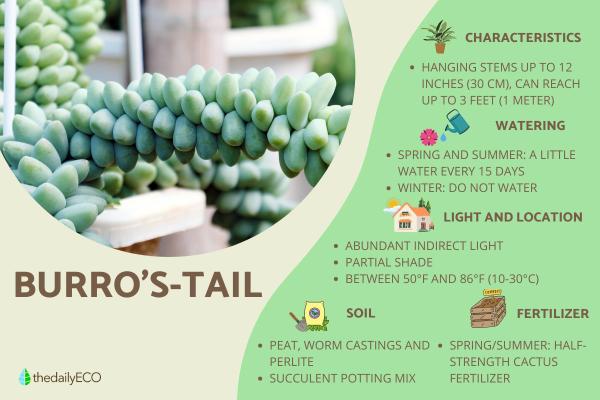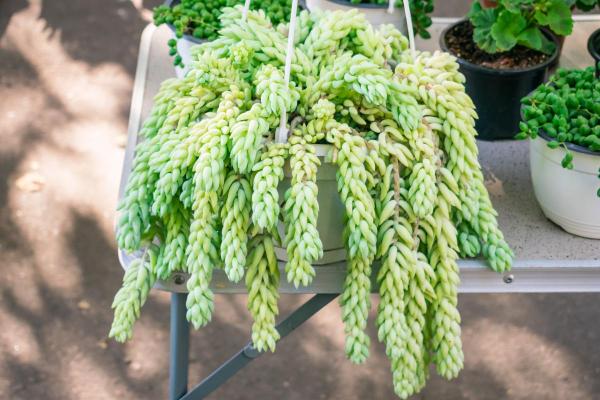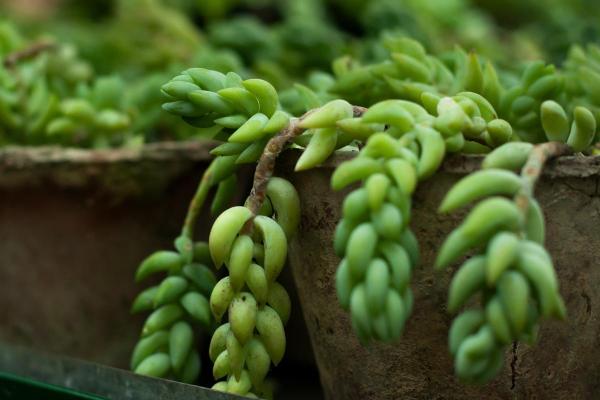How to care for Burro’s-Tail?


Native to the sun-drenched regions of Mexico, this distinctive succulent, commonly known as Burro's Tail or Donkey's Tail, has become increasingly popular among plant enthusiasts for good reason. It combines show-stopping visual appeal with relatively straightforward care requirements, making it accessible even to those still developing their green thumb. The trademark blue-green stems create a waterfall effect that adds texture and interest to any indoor space.
This article by thedailyECO, offers clear, practical advice on everything from basic Burro's Tail care to troubleshooting common problems.
Characteristics of Burro’s-tail
Mature Burro's Tail plants have a unique appearance that few other houseplants can match:
- Those long, droopy stems can stretch up to a foot long for average plants, but spectacular specimens trailing down 3 feet or more aren't uncommon when conditions are ideal.
- They're born to hang, placing one on a high shelf or in a hanging basket shows off their natural growth habit.
- The leaves aren't flat like most plants. Instead, they're chubby little tubes that overlap like fish scales or, well, a burro's tail. They store water inside (classic succulent move) which makes these plants surprisingly drought-resistant.
- Each leaf attaches to the stem by what seems like the plant equivalent of a weak handshake. Breathe too hard and they'll fall off. This is completely normal but drives some owners nuts.
- With perfect conditions, tiny pink or red flowers might appear at the stem tips. Don't hold your breath waiting for this, though, many perfectly healthy plants never flower indoors.
- Plant shops often sell something labeled "burrito" variety, it's similar but with rounder, shorter leaves. Some people find it less prone to leaf drop, but the classic Burro's Tail has a more dramatic trailing form when mature.
The good news? Despite these quirks, these plants are remarkably unfussy once the basics are right.
Light, temperature and location of Burro’s-tail
Direct, scorching afternoon sun? That's a hard no. These plants evolved to grow under rocky overhangs and in the dappled shade of larger plants in their native Mexico. They want bright conditions without the burn.
The sweet spot is what plant people call "bright indirect light." East-facing windows are typically perfect. Morning sun is gentle enough not to cause harm. A west-facing window can work too, as long as the plant sits back a bit from the glass or has some filtering from a sheer curtain. North-facing? Usually too dim unless it's a very bright room. South-facing windows pack too much of a punch unless the plant is several feet away from the glass.
Signs of proper light include:
- New growth maintaining that gorgeous blue-green color
- The plant not stretching or leaning awkwardly toward light sources
- Leaves growing fairly close together along the stems
If stems start stretching with bigger gaps between leaves (etiolation), the plant is basically sending up a distress flare saying more light, please.
A quick temperature note, these aren't cold-hardy plants at all. They'll turn to mush below about 40°F, so they shouldn't be left outside when temperatures drop. The ideal range is between 50-86°F, which conveniently matches most indoor environments. In winter, keep them away from drafty windows and heat vents which can cause temperature swings.

Substrate of Burro’s-tail
Regular potting soil is a death sentence for these plants. The problem is water retention. Standard potting mixes hold moisture like a sponge, which is great for thirsty plants but disastrous for succulents. Burro's Tail roots will rot in constantly damp conditions faster than anyone can say "overwatering."
So what's the answer? Drainage, drainage, drainage.
There are two main options:
- Buy premixed succulent/cactus soil from any garden center. Easy and foolproof, if a bit pricey.
- Hack regular potting soil by mixing in plenty of perlite, pumice, or coarse sand. A typical blend uses about 50% regular potting soil and 50% drainage materials. In very humid climates, bumping that up to 60% drainage materials works better.
Whichever route is chosen, the pot must have drainage holes. Terra cotta pots are particularly good for Burro's Tail because the clay wicks away excess moisture. Plastic works fine too, but requires more careful watering.
As for fertilizer, these plants aren't big eaters. A diluted (like, half-strength) cactus fertilizer once in spring and once in summer is plenty. Skip it entirely in fall and winter when growth naturally slows.
Watering of Burro’s-tail
Here's the single most important thing to remember about watering Burro's Tail: when in doubt, don't.
These plants have evolved over thousands of years to survive drought conditions. Those chubby little leaves are essentially water balloons, storing moisture for the plant to use during dry spells. This means Burro's Tail can go much longer without water than most people might expect.
The classic mistake is sticking to a rigid watering schedule. Forget the calendar, the plant doesn't care what day it is. Instead, let the soil be the guide. Wait until it's completely dry, then wait another day or two just to be sure. Yes, really.
When watering, do it thoroughly. Soak the soil until water runs freely from the drainage holes, then empty the saucer. This encourages deeper root growth.
Seasonal adjustments are necessary:
- Summer: maybe every 2-3 weeks, depending on heat and humidity.
- Spring/Fall: probably closer to once a month.
- Winter: barely at all – maybe once every 6 weeks if the home is warm and dry.
Signs of overwatering include soft, mushy stems, yellowing or transparent leaves, and leaf drop that seems to come from the middle of stems rather than just the tips. Underwatering is actually less common but shows up as shriveled, wrinkled leaves and dried-out stem tips.

Pruning of Burro’s-tail
Unlike most houseplants, Burro's Tail doesn't really need regular pruning for health reasons. These plants naturally grow as long, trailing stems – that's their whole vibe. But sometimes they get too long for their space or start looking a bit scraggly.
Reproduction of Burro’s-tail
If a plant has stretched out with widely spaced leaves (usually from insufficient light), don't worry. There's a silver lining here. Those leggy stems make perfect propagation material. This brings us to one of the most rewarding aspects of growing Burro's Tail is making more plants.
This isn't even really a method, it's just what happens when leaves get knocked off the plant (which will happen, guaranteed). Simply:
- Gather fallen leaves. Even the ones that have been on the floor for a day or two might still be viable.
- Let them sit on a paper towel for 2-3 days to callus over.
- Lay them on top of some dry succulent soil, don't bury them.
- Mist very occasionally when the soil surface is bone dry.
Eventually, most leaves will grow tiny roots, followed by an adorable baby plant at the leaf base.

Diseases and pests of Burro’s-tail
While Burro's Tail isn't exactly a pest magnet, problems can still crop up occasionally. Here's what to watch for:
Powdery mildew: looks exactly like it sounds, a white, powder-like coating on leaves and stems. It typically appears when air circulation is poor and humidity is high. To fix it, move the plant somewhere with better airflow and reduce overhead watering (water the soil, not the plant). A fungicide made for succulents can help in severe cases, but improving conditions is usually enough.
Root and stem rot: is the real killer. It starts below the soil line where it can't be seen, then progresses up the plant. By the time stems turn black and mushy above soil level, it's often too late for those sections. This is almost always caused by overwatering or poorly draining soil. If caught early:
- Unpot the plant and remove all wet soil
- Cut away any mushy, dark roots or stems with a clean knife
- Let the plant dry out for several days
- Repot in fresh, dry succulent soil
- Wait at least a week before watering
As for pests, three main culprits occasionally bother Burro's Tail:
- Mealybugs: appear as small white cotton-like clusters, usually in leaf joints or under leaves. They're annoying but treatable with a cotton swab dipped in rubbing alcohol applied directly to the bugs.
- Scale: looks like small brown bumps stuck to stems. They don't even look like insects, more like weird growth on the plant. Same treatment – rubbing alcohol on a cotton swab works well for small infestations.
- Aphids: are less common but might appear as tiny green, black, or white insects clustered on new growth. A spray of diluted dish soap (just a drop in water) can often take care of them.
For any pest problem, isolation is key, move the affected plant away from other plants immediately to prevent spread. For serious infestations, insecticidal soap or neem oil might be necessary, but start with the gentlest solutions first.
If you want to read similar articles to How to care for Burro’s-Tail?, we recommend you visit our Plant care and cultivation category.
- Becherer, F. (2003). Cactus & Co.: Quick and Easy. Spain: Editorial Hispano Europea, SA
- Cactus and other succulent plants. (2017). Spain: Larousse.








